Lee Kun-hee’s spirit of innovation should thrive long after the Chairman is gone
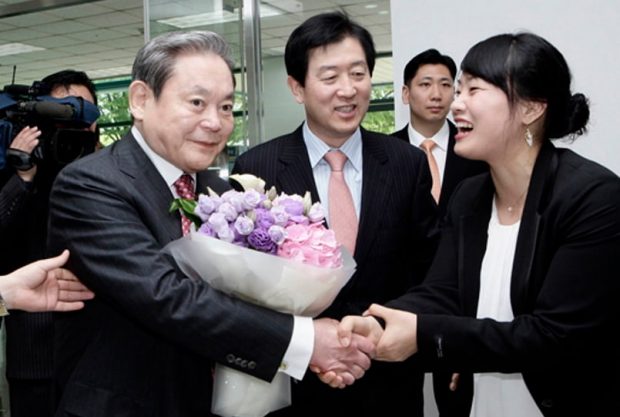
Samsung Chairman Lee Kun-hee in 2010
By Habib Toumi
Bahrain: I visited South Korea for the first time in March 2019, a guest of the Journalists Association of Korea (JAK) and the Asia Journalists Association (AJA) and a speaker at the World Journalists Conference.
I have heard and read a lot about South Korea, so it was impossible for me to arrive at the majestic Incheon Airport without preconceptions about the country, its flagship brand Samsung’s endless quest for greater and more amazing technology, and the latest political developments on the Korean Peninsula.
Yet, throughout the week I spent in the country, Korea showed me how it always finds ways to awe its visitors, delve with them into history, soar with them to new heights of technology and win their hearts and minds.
From towering skyscrapers to underground museums, the sobering Jinkwansa Temple to the defiant Saemangeum Seawall, the ultramodern Samsung City to the historic Changgyeonggung Palace, Korea is a country that challenges myths, marches to its own beat and invites visitors to join in the experience with unrestrained enthusiasm.
Yet, one of the most impressive and memorable times I was lucky to experience in South Korea was the visit to Samsung Digital City.
I have been to Nokia when I visited Finland, and I more or less had expected to see something similar in Suwon, the city where Galaxy mobiles are developed and tested, the first designs for Samsung’s Curved UHD TVs were sketched and many other cool gadgets are conceptualized.
I was wrong. Completely wrong. In Suwon, the headquarters of Samsung, I entered a different world, more like Alice in Wonderland.

Samsung Digital City in Suwon (Samsung)
Welcome to Samsung Digital City.
It is not a city, but rather a well-manicured campus where some of the world’s brightest minds work, push their limits back through brainstorming and create new devices. Tradition has it that Samsung, meaning three stars, does not enter a market unless it believes it can one day become its leader. Under the leadership culture so well instilled in their minds, all employees are involved in that push towards the top rank.
The “city” boasts 390 acres of office space, 35,000 Samsung employees, four landmark office towers up to 38 floors high, 131 smaller buildings with more labs, offices, recreational facilities, and a guesthouse for visiting researchers, a heliport, a shuttle helicopter and 500 shuttle buses to 103 destinations.
It also has ten basketball courts, four badminton courts, three football fields and two baseball diamonds. Employees can join any of the 650 clubs available. And they do not have to worry about their children since more than 150 teachers look after close to 1,000 children to support working parents.
According to Samsung newsroom, engineers, developers, and designers can turn up for work at any time before 6pm, as long as they feel efficient and productive. Samsung calls it “Work Smart.”
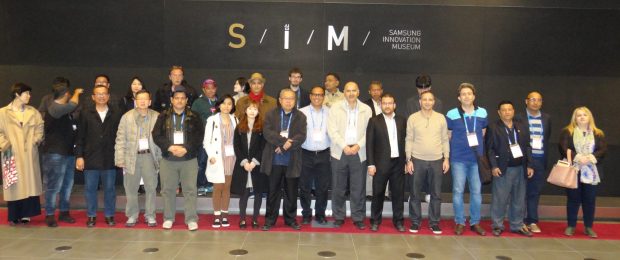
International journalists at the start of an outstanding visit to the Samsung Innovation Museum (SIM) in Suwon
Every day, Samsung Digital City serves up 72,000 meals free. Whether it’s breakfast, lunch or dinner, the food courts offer 92 different menus.
If there is no past, there is no future! The Samsung Innovation Museum showcases the evolution of the electronics industry around the world with many original devices over the past 270 years.
Healthcare service is free at Samsung Digital City, with numerous medical facilities that offer everything from physicals and flu shots, to dental treatments and traditional acupuncture.
Security is understandably tight, but not obtrusive. The spacious conference room where we journalists were briefed is the size of a basketball dome. A far cry from the long or round table where some corporations or companies assemble their guests or senior staff for meetings.
Following the briefing, we are invited to a trip down memory lane in the company museum where we are taken back in time to view old television sets showing old programs and speeches, refrigerators, phones, and other devices, and a phone designed for the movie “The Matrix.”

Samsung Digital City in Suwon (Samsung)
We were introduced to some of the latest technologies, increasing our awe and boosting our respect for a company and its triumph-driven culture across the years.
On October 20 this year, Samsung Electronics announced that it has become number five in the Best Global Brands 2020 list announced by Interbrand, a global brand consulting company, with its largest-ever brand value of $62.3 billion.
Despite the challenging business environment brought on global companies by COVID-19 in 2020, Samsung saw a 2% rise in brand value and ascended to the global top five in three years after reaching number six in the list of Best Global Brands 2017.
The success is consistent with the company’s steady progress. It started in the 43rd place in 2000 when Interbrand began publishing the Best Global Brands, became ninth in 2012, sixth in 2017 and fifth in 2020.
Samsung said that the upwards move in Interbrand’s list of 100 most valuable brands in the world was “backed by the continuous introduction of innovative products and implementation of broad marketing activities on the global stage.”
In explaining the Samsung ranking, Interbrand said that the major factors that played a critical role in Samsung’s growth were a rapid response to COVID-19 through global activities for corporate social responsibility (CSR) and integrated global campaign and company-wide activities dedicated to sustainable development.
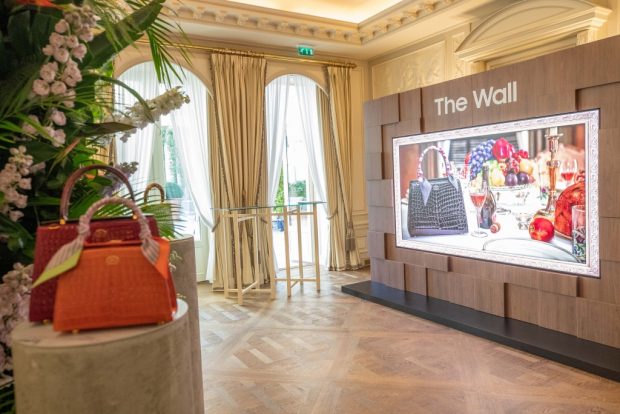
Samsung showcases its latest technology ‘The Wall Luxury’ during Paris Fashion Week and the Monaco Yacht Show, two events that have a significant role in establishing cultural trends and style innovations in design, fashion, lifestyle, and beyond (Samsung)
The continuous launch of innovative products including Galaxy Fold, The Terrace and BESPOKE refrigerator and the consistent investment to lead the development of advanced technologies, such as Artificial Intelligence (AI), 5G and Internet of Things (IoT) were among the main contributors that drove the company’s growth into the top five.
As the dazzling lists of business accomplishments, social achievements and outstanding figures whizz through the head, the question that comes to mind is: Who is behind the radical growth of Samsung from a company making televisions and microwaves to the tech giant of smartphones, television and computer chips that it is today?
Samsung was founded by Lee Byung-Chul, Kun-Hee’s father, on March 1, 1938 as an exporter of fruit and dried fish. The company expanded into textiles, sugar and other consumer goods before moving to insurance, shipbuilding and semiconductors and others.
When it belatedly started industrialization in the second half of the 20th century, South Korea had the reputation of making cheap second- or third-class imitations, and struggled to catch up with the advanced economies of the West. Samsung was the third-largest company in Korea, but had limited presence internationally.
Lee Byung-Chul died in 1987 and Lee Kun-Hee, 45, took over as Chairman. He immediately set about changing the way the company’s employees thought and operated.
In his book, Samsung Electronics, Tony Michell reported that in the 1970s, Lee observed, “as the nation has virtually no natural resources, the high-tech industry was the only means of survival for the Korean economy.”

Samsung installs momentous new LED displays in the heart of New York`s Times Square (Samsung)
A well-known aphorism that he uttered during a meeting with executives, “Change everything except your wife and children,” reflects the new mindset that should drive the company’s forward-looking innovation that would lead ultimately to Samsung becoming a global business leader and motivating other Korean companies to step up overseas inroads.
According to reports, Lee, during a visit in 1995 to a Samsung Electronics plant in Gumi, North Gyeongsang Province, he was so angered by the low-quality products being produced by the company at the time that he ordered that the defective electronic products in the company’s Gumi factory yard be brought out and burnt.
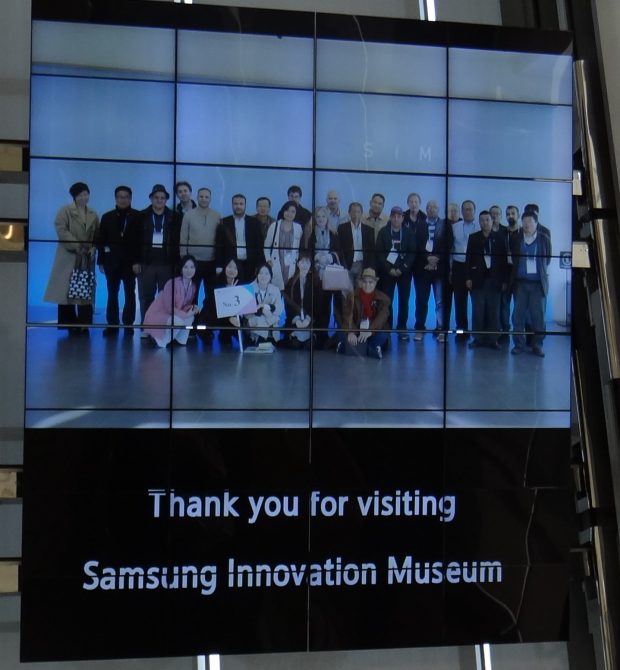
The group visit to Samsung Innovation Museum in Suwon (Samsung)
In the yard, each of the 2,000 factory staff wore a headband with the caption ‘Quality First’ while Lee and the board sat under a banner with the caption “Quality Is My Pride.”
They all watched as thousands of cellphones were smashed and set on fire. They had been given to employees as Christmas presents, then found to be defective, and Lee wanted to make a point. Many of the workers wept as a bulldozer carried away the ashes, the reports said.
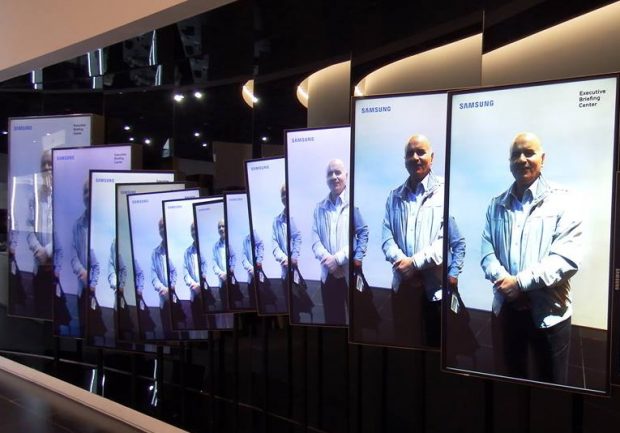
During the visit to Samsung Innovation Museum in Suwon
The message was clear: The priority of management has shifted from quantity to quality. Lee’s mentality of do-or-die pursuit of quality has eventually taken Samsung to the top rank globally in semiconductors, smartphones and televisions.
Has passed away, but his multiple legacies remain. The main one is the relentless and inexorable pursuit of world-class excellence. And as he cautioned almost three decades ago, this pursuit cannot be confined to companies. It must also include the country’s government, politicians and policies for they can either stall corporate growth and discourage business or promote its development and motivate its progress.
The Lee Kun-hee’s spirit of innovation should thrive long after the Chairman is gone.




















































